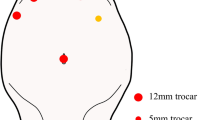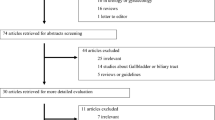Abstract
Background
There is a growing interest in using laparoscopy for hepatic resection. However, structured training is lacking in part because of the lack of an ideal animal training model. We sought to identify an animal model whose liver anatomy significantly resembled that of the human liver and to assess the feasibility of learning laparoscopic hepatic inflow and outflow dissection and parenchyma transection on this model.
Methods
The inflow and outflow structures of the sheep liver were demonstrated via surgical dissection and contrast studies. Laparoscopic left major hepatic resections were performed.
Results
The portal hepatis of all 12 sheep (8 for anatomic study and 4 for laparoscopic hepatic resection) resembled that of human livers. The portal vein (PV) was located posteriorly; the common hepatic artery (CHA) and the common bile duct (CBD) were located anterior medially and anterior laterally with respect to the portal hepatis. The main PV bifurcated into a short right and a long left PV. The extrahepatic right PV then bifurcated into right posterior and anterior sectoral PV. The CBD and CHA bifurcated into left and right systems. The cystic duct originated from the right hepatic duct. The cystic artery originated from the right HA in 11/12 animals. The left hepatic vein drained directly into the inferior vena cava (IVC). The middle and the right hepatic veins formed a short common channel before entering the IVC. Multiple venous tributaries drained directly into IVC. Familiarity with sheep liver anatomy allowed laparoscopic left hepatic lobe (left medial and lateral segments) resection to be performed with accuracy and preservation of the middle hepatic vein.
Conclusions
The surgical anatomy of sheep liver resembled that of human liver. Laparoscopic major hepatic resection can be performed with accuracy using this information. Sheep is therefore an ideal animal model for advanced surgical training in laparoscopic hepatic resection.











Similar content being viewed by others
References
Aggarwal R, Darzi A (2005) Training in laparoscopy—which model to use? Indian J Gastroenterol 24(3): 95–96
Berney T, Mentha G, Roth AD, Morel P (1998) Results of surgical resection of liver metastases from non-colorectal primaries. Br J Surg 85(10): 1423–1427
Buell JF, Thomas MJ, Doty TC, Gersin KS, Merchen TD, Gupta M, Rudich SM, Woodle ES (2004) An initial experience and evolution of laparoscopic hepatic resectional surgery. Surgery 136(4): 804–811
Cherqui D, Emond JC, Pietrabissa A, Michel M, Roncella M, Brown SB, Whitington PF, Broelsch CE (1990) Segmental liver transplantation from living donors. Report of the technique and preliminary results in dogs. HPB Surg 2(3): 189–202; discussion 202–204
Cherqui D, Husson E, Hammoud R, Malassagne B, Stephan F, Bensaid S, Rotman N, Fagniez PL (2000) Laparoscopic liver resections a feasibility study in 30 patients. Ann Surg 232: 753–762
Chua HK, Sondenaa K, Tsiotos GG, Larson DR, Wolff BG, Nagorney DM (2004) Concurrent vs. staged colectomy and hepatectomy for primary colorectal cancer with synchronous hepatic metastases. Dis Colon Rectum 47(8): 1310–1316
Chung KY, Kim MS, Lee JH, Kim YS, Choi KJ, Choi YM (2002) Live donor partial liver harvest for canine liver transplantation: development of an innovative technique for surgical training and research. Surg Today 32(8): 711–715
Cuschieri A (2005) Laparoscopic surgery: current status, issues and future developments. Surgeon 3(3): 125–130, 132–13, 135–138 [review]
Cuschieri A, Hunter J, Wolfe B, Swanstrom LL, Hutson W (1993) Multicenter prospective evaluation of laparoscopic antireflux surgery. Preliminary report. Surg Endosc 7(6): 505–510
DeMatteo RP, Palese C, Jarnagin WR, Sun RL, Blumgart LH, Fong Y (2000) Anatomic segmental hepatic resection is superior to wedge resection as an oncologic operation for colorectal liver metastases. J Gastrointest Surg 4(2): 178–184
Descottes B, Glineur D, Lachachi F, et al. (2003) Laparoscopic liver resection of benign liver tumors. Surg Endosc 17(1): 23–30
Flowers JL, Jacobs S, Cho E, Morton A, Rosenberger WF, Evans D, Imbembo AL, Bartlett ST (1997) Comparison of open and laparoscopic live donor nephrectomy. Ann Surg 226: 483–489
Fong Y, Jarnagin W, Conlon KC, DeMatteo R, Doughterty E, Blumgart LH (2000) Hand-assisted laparoscopic liver resection lessons from an initial experience. Arch Surg 135: 854–859
Gigot JF, Glineur D, Santiago Azagra J, et al. (2002) Laparoscopic liver resection for malignant liver tumors: preliminary results of a multicenter European study. Ann Surg 236(1): 90–97
Gutt CN, Riemer V, Brier C, Berguer R, Paolucci V (1998) Standardized technique of laparoscopic surgery in the rat. Dig Surg 15(2): 135–139
Hawn MT, Cook D, Deveney C, Sheppard BC (2002) Quality of life after laparoscopic bilateral adrenalectomy for Cushing’s disease. Surgery 132(6): 1064–1068; discussion 1068–1069
Hunter JG, Trus TL, Branum GD, Waring JP, Wood WC (1996) A physiologic approach to laparoscopic fundoplication for gastroesophageal reflux disease. Ann Surg 223(6): 673–685; discussion 685–687
Kuntz C, Kienle P, Schmeding M, Benner A, Autschbach F, Schwalbach P (2002) Comparison of laparoscopic versus conventional technique in colonic and liver resection in a tumor-bearing small animal model. Surg Endosc 16(8): 1175–1181
Lin E, Gonzalez R, Venkatesh KR, Mattar SG, Bowers SP, Fugate KM, Heffron TG, Smith CD (2003) Can current technology be integrated to facilitate laparoscopic living donor hepatectomy? Surg Endosc 17(5): 750–753
Machado MA, Galvao FH, Pompeu E, Ribeiro C, Bacchella T, Machado MC (2004) A canine model of laparoscopic segmental liver resection. J Laparoendosc Adv Surg Tech A 14(5): 325–328
Nishio H, Hidalgo E, Hamady ZZ, Ravindra KV, Kotru A, Dasgupta D, Al-Mukhtar A, Prasad KR, Toogood GJ, Lodge JP (2005) Left hepatic trisectionectomy for hepatobiliary malignancy: results and an appraisal of its current role. Ann Surg 242(2): 267–275
O’Rourke N, Fielding G (2004) Laparoscopic right hepatectomy: surgical technique. J Gastrointest Surg 8(2): 213–216
Pinto PA, Montgomery RA, Ryan B, Roberts W, Hsu T, Kavoussi P, Klein AS, Kavoussi LR, Molmenti EP (2003) Laparoscopic procurement model for living donor liver transplantation. Clin Transplant 17 (Suppl 9): 39–43
Soper NJ, Brunt LM, Kerbl K (1994) Laparoscopic general surgery. N Engl J Med 330: 409–419
Stefanidis D, Korndorffer JR Jr, Sierra R, Touchard C, Dunne JB, Scott DJ (2005) Skill retention following proficiency-based laparoscopic simulator training. Surgery 138(2): 165–170
Supe A, Dalvi A, Prabhu R, Kantharia C, Bhuiyan P (2005) Cadaver as a model for laparoscopic training. Indian J Gastroenterol 24(3): 111–113
Vibert E, Perniceni T, Levard H, Denet C, Shahri NK, Gayet B (2006) Laparoscopic liver resection. Br J Surg 93: 67–72
Wayand W, Woisetschlager R (1993) Laparoscopic resection of liver metastasis. Chirurg 64(3): 195–197
Wu JS, Strasberg SM, Luttmann DR, Meininger TA, Talcott MR, Soper NJ (1998) Laparoscopic hepatic lobectomy in the porcine model. Surg Endosc 12(3): 232–235
Author information
Authors and Affiliations
Corresponding author
Rights and permissions
About this article
Cite this article
Teh, S.H., Hunter, J.G. & Sheppard, B.C. A suitable animal model for laparoscopic hepatic resection training. Surg Endosc 21, 1738–1744 (2007). https://doi.org/10.1007/s00464-007-9209-9
Received:
Revised:
Accepted:
Published:
Issue Date:
DOI: https://doi.org/10.1007/s00464-007-9209-9




